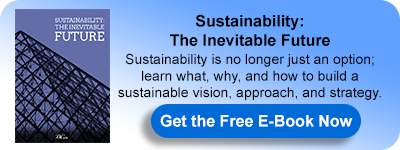Sustainability: the Mother of Innovation
When the hit competition reality series Project Runway returned for a 12th popular season, 24-year-old Timothy Westbrook was among the innovative fashion designers competing on the show. Westbrook introduced sustainable innovation to Project Runway. He creates high fashion clothing out of trash.
During his Project Runway audition, Westbrook wowed the judges with beaded evening dresses made out of magnetic tape he harvested from discarded audio cassettes. Later this year, he will present a 24-piece fashion show made from fabric woven from plastic trash bags. His goal is to "reinvent the expiration date of stuff."
Mottainai
Westbrook exemplifies the Japanese concept of mottainai. Mottainai takes the traditional three Rs of sustainability -- reduce, reuse, recycle -- and combines them with a fourth R: respect for the planet and its scarce resources.
In Japan, mottainai is a trigger for innovation. Designers who embrace mottainai create multipurpose products that simplify consumers' lives and ease the burden of mass manufacturing on the environment.
Furoshiki embodies mottainai
The square Japanese cloth called furoshiki is an example of mottainai-inspired innovation that drives form and function. Available in beautiful seasonal prints, the colorful cloth can be tied and folded to function as a scarf, a tote, a shoulder bag and a shopping bag. Its owner can keep one item instead of several items, which in turn can reduce the amount of storage space she needs in her home.
Furoshiki is often used as gift wrap, as it adapts to the form of both common boxy gifts and unusually shaped items. The recipient of a gift wrapped in furoshiki then extends the mottainai tradition by integrating the fabric into her own household as a carry bag or piece of apparel.
The rise of mottainai
The concept of mottainai went viral after it was popularized by Nobel Prize winner Wangari Maathai, who learned the term during a 2005 visit to Japan. Mottainai ideals have been integrated into daily life in Japan; however, businesses have been slow to adopt the design principles into their processes.
One Japanese business that successfully leverages mottainai in its business practices is NAKADAI Co. Ltd., a waste management company. Nakadai sponsors a workshop known as Mono Factory (translated, "Stuff Factory"), where participants deconstruct items that have been discarded as garbage by others. The disassembled parts become new resources called Social Materials, which are then used to create new products. Participants leave the Mono Factory workshop with badges, bookmarks and mobiles created from Social Materials. Nakadai recycles any materials that are left over after each workshop.
Mottainai goes mainstream
The concept of sustainable design as innovation is catching on in other industries as businesses compete to be seen as "green" in the eye of the consumer. Recent examples of mottainai creeping into mainstream design include the following:
- Industrial equipment manufacturer Caterpillar developed a sustainability program that recycles 1.4 million lbs. of scrap materials every year into refurbished machine components that customers can buy at reduced prices.
- The Sustainable Apparel Coalition brings clothing competitors together to incorporate mottainai principles in their designs.
- A bread company developed a perforated bag that closes with a knot, eliminating the need for wire twist ties and plastic closure tabs in its packaging.
- An apparel company introduced a modular design that functions as a ten-piece wardrobe, including a dress, jacket, coat and skirt. After one year, the consumer returns the garment to the manufacturer, who recycles it.
- A cleaning product manufacturer developed a line of concentrated products that consumers add tap water to before using them. This innovation eliminates the fuel and other resources required to ship water, which is the primary ingredient found in most cleaning products.
The future of mottainai
The recycling renaissance is here to stay. As consumers incorporate mottainai ideals into their everyday lives, they will demand sustainable innovation in the products they use. Industrial leaders must evolve to maintain their competitive advantage, and the resulting design revolution will benefit business, consumers and the planet.
For more about the topic of sustainability, download our latest book " Sustainability: The Inevitable Future " for FREE:
